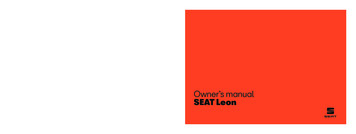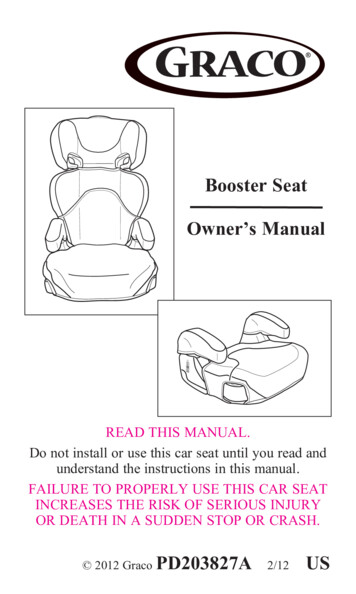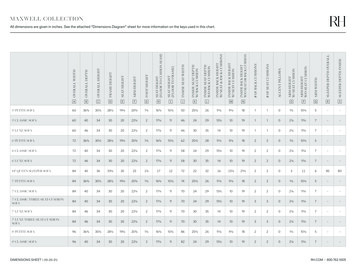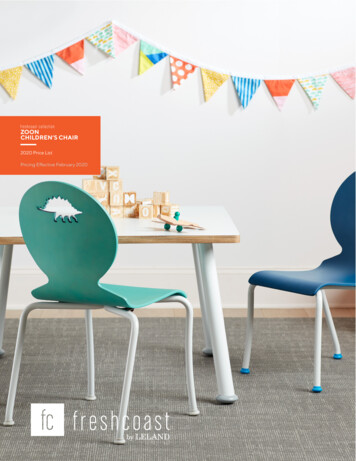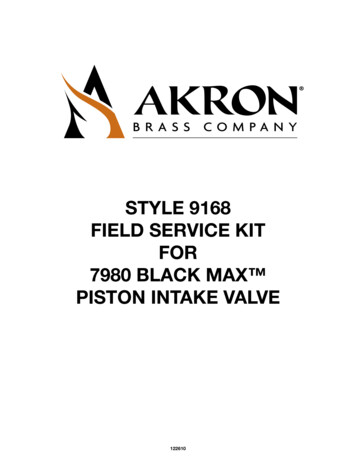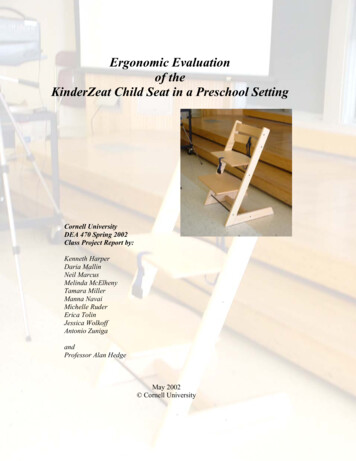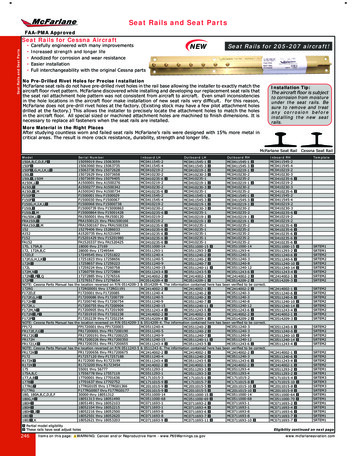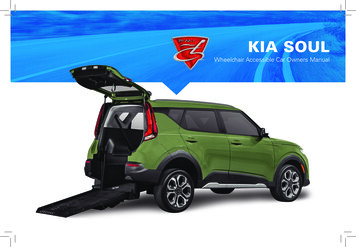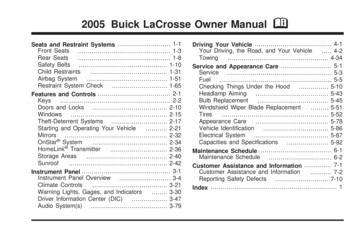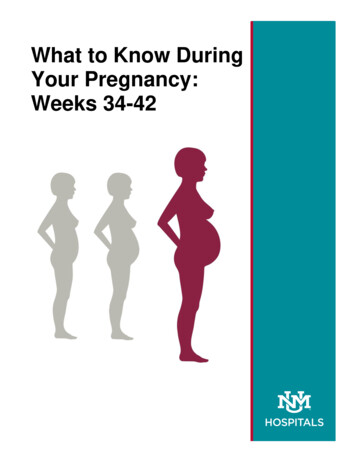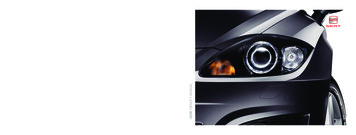
Transcription
Portada LEON.indd 318/07/11 16:55LEON OWNER’S MANUALLEON Inglés (07.11)Inglés 1P0012003EE (07.11) (GT9)1P0012003EE
ForewordThis Instruction Manual and its corresponding supplements should be read carefully to familiarise yourselfwith your vehicle.Besides the regular care and maintenance of the vehicle, its correct handling will help preserve its value.For safety reasons, note the information concerning accessories, modifications and part replacements.If selling the vehicle, give all of the on-board documentation to the new owner, as it should be kept with thevehicle.
Table of ContentsTable of ContentsManual structureContent.Safety First . . . . . . . . . . . . . . . . . . . . . . . . . . . .Safe driving . . . . . . . . . . . . . . . . . . . . . . . . . . . . . . .Brief introduction . . . . . . . . . . . . . . . . . . . . . . . . .Proper sitting position for occupants . . . . . . . . .Pedal area . . . . . . . . . . . . . . . . . . . . . . . . . . . . . . .Storing objects . . . . . . . . . . . . . . . . . . . . . . . . . . .Seat belts . . . . . . . . . . . . . . . . . . . . . . . . . . . . . . . . .Brief introduction . . . . . . . . . . . . . . . . . . . . . . . . .Why wear seat belts? . . . . . . . . . . . . . . . . . . . . . .Seat belts . . . . . . . . . . . . . . . . . . . . . . . . . . . . . . .Seat belt tensioners . . . . . . . . . . . . . . . . . . . . . . .Airbag system . . . . . . . . . . . . . . . . . . . . . . . . . . . . .Brief introduction . . . . . . . . . . . . . . . . . . . . . . . . .Front airbags . . . . . . . . . . . . . . . . . . . . . . . . . . . . .Side airbags* . . . . . . . . . . . . . . . . . . . . . . . . . . . .Curtain airbags . . . . . . . . . . . . . . . . . . . . . . . . . . .Deactivating airbags* . . . . . . . . . . . . . . . . . . . . . .Child safety . . . . . . . . . . . . . . . . . . . . . . . . . . . . . . .Brief introduction . . . . . . . . . . . . . . . . . . . . . . . . .Child seats . . . . . . . . . . . . . . . . . . . . . . . . . . . . . . .Securing child seats . . . . . . . . . . . . . . . . . . . . . . g Instructions.55Cockpit . . . . . . . . . . . . . . . . . . . . . . . . . . . . . . . . . . .55555760616877Overview . . . . . . . . . . . . . . . . . . . . . . . . . . . . . . . .Instruments . . . . . . . . . . . . . . . . . . . . . . . . . . . . . .LPG system* . . . . . . . . . . . . . . . . . . . . . . . . . . . . .Digital instrument panel display . . . . . . . . . . . . .Instrument panel menus* . . . . . . . . . . . . . . . . . . .Warning lamps . . . . . . . . . . . . . . . . . . . . . . . . . . .Steering wheel controls . . . . . . . . . . . . . . . . . . . .General information . . . . . . . . . . . . . . . . . . . . . . .Audio system . . . . . . . . . . . . . . . . . . . . . . . . . . . . .Radio navigation system . . . . . . . . . . . . . . . . . . .Unlocking and locking . . . . . . . . . . . . . . . . . . . . .Central locking . . . . . . . . . . . . . . . . . . . . . . . . . . .Keys . . . . . . . . . . . . . . . . . . . . . . . . . . . . . . . . . . . .Radio frequency remote control . . . . . . . . . . . . . .Anti-theft alarm system* . . . . . . . . . . . . . . . . . . .Tailgate . . . . . . . . . . . . . . . . . . . . . . . . . . . . . . . . .Windows . . . . . . . . . . . . . . . . . . . . . . . . . . . . . . . .Sliding/tilting sunroof* . . . . . . . . . . . . . . . . . . . .Lights and visibility . . . . . . . . . . . . . . . . . . . . . . . .Lights . . . . . . . . . . . . . . . . . . . . . . . . . . . . . . . . . . .Interior lights . . . . . . . . . . . . . . . . . . . . . . . . . . . . .Visibility . . . . . . . . . . . . . . . . . . . . . . . . . . . . . . . . .Windscreen wipers . . . . . . . . . . . . . . . . . . . . . . . .Rear-view mirrors . . . . . . . . . . . . . . . . . . . . . . . . .Seats and storage compartments . . . . . . . . . .The importance of correct seat adjustment . . . . .Head restraints . . . . . . . . . . . . . . . . . . . . . . . . . . .Front seats . . . . . . . . . . . . . . . . . . . . . . . . . . . . . . .Rear seats . . . . . . . . . . . . . . . . . . . . . . . . . . . . . . .Storage compartment . . . . . . . . . . . . . . . . . . . . . 32132133135137138Ashtrays*, cigarette lighter* and electricalsockets . . . . . . . . . . . . . . . . . . . . . . . . . . . . . . . . . .First-aid kit, warning triangle, fire extinguisher .Luggage compartment . . . . . . . . . . . . . . . . . . . . .Air conditioning . . . . . . . . . . . . . . . . . . . . . . . . . . .Heating . . . . . . . . . . . . . . . . . . . . . . . . . . . . . . . . .Climatic* . . . . . . . . . . . . . . . . . . . . . . . . . . . . . . . .2C-Climatronic* . . . . . . . . . . . . . . . . . . . . . . . . . . .General notes . . . . . . . . . . . . . . . . . . . . . . . . . . . .Driving . . . . . . . . . . . . . . . . . . . . . . . . . . . . . . . . . . . .Steering . . . . . . . . . . . . . . . . . . . . . . . . . . . . . . . . .Safety . . . . . . . . . . . . . . . . . . . . . . . . . . . . . . . . . . .Ignition lock . . . . . . . . . . . . . . . . . . . . . . . . . . . . . .Starting and stopping the engine . . . . . . . . . . . .Driving with LPG* . . . . . . . . . . . . . . . . . . . . . . . . .Start-Stop function* . . . . . . . . . . . . . . . . . . . . . . .Manual gearbox . . . . . . . . . . . . . . . . . . . . . . . . . .Automatic gearbox* / DSG automatic gearbox* .Handbrake . . . . . . . . . . . . . . . . . . . . . . . . . . . . . . .Acoustic parking aid system* . . . . . . . . . . . . . . .Cruise speed* (Cruise control system) . . . . . . . .Practical 67168173175178.182Intelligent technology . . . . . . . . . . . . . . . . . . . . .182182Brakes . . . . . . . . . . . . . . . . . . . . . . . . . . . . . . . . . .Anti-lock brake system and traction control MABS (ABS and ASR (TCS)) . . . . . . . . . . . . . . . . . . .Electronic Stability Control ESC (ESP)* . . . . . . . .Driving and the environment . . . . . . . . . . . . . . .Running-in . . . . . . . . . . . . . . . . . . . . . . . . . . . . . . .Exhaust gas purification system . . . . . . . . . . . . .Economical and environmentally friendly drivingDriving abroad . . . . . . . . . . . . . . . . . . . . . . . . . . . .1831841891891901911943
4Table of ContentsTrailer towing . . . . . . . . . . . . . . . . . . . . . . . . . . . . . .Instructions to follow . . . . . . . . . . . . . . . . . . . . . .Ball coupling of towing bracket* . . . . . . . . . . . . .Driving tips . . . . . . . . . . . . . . . . . . . . . . . . . . . . . .Fitting a towing bracket* . . . . . . . . . . . . . . . . . . .Vehicle maintenance and cleaning . . . . . . . . .General notes . . . . . . . . . . . . . . . . . . . . . . . . . . . .Care of the vehicle exterior . . . . . . . . . . . . . . . . . .Vehicle interior maintenance . . . . . . . . . . . . . . . .Accessories, parts replacement andmodifications . . . . . . . . . . . . . . . . . . . . . . . . . . . . .Accessories and spare parts . . . . . . . . . . . . . . . .Technical modifications . . . . . . . . . . . . . . . . . . . .Roof aerial* . . . . . . . . . . . . . . . . . . . . . . . . . . . . . .Mobile phones and two-way radios . . . . . . . . . . .Checking and refilling levels . . . . . . . . . . . . . . .Refuelling . . . . . . . . . . . . . . . . . . . . . . . . . . . . . . .LPG system* . . . . . . . . . . . . . . . . . . . . . . . . . . . . .Petrol . . . . . . . . . . . . . . . . . . . . . . . . . . . . . . . . . . .Diesel . . . . . . . . . . . . . . . . . . . . . . . . . . . . . . . . . . .Working in the engine compartment . . . . . . . . . .Engine oil . . . . . . . . . . . . . . . . . . . . . . . . . . . . . . . .Coolant . . . . . . . . . . . . . . . . . . . . . . . . . . . . . . . . .Washer fluid and windscreen wiper blades . . . .Brake fluid . . . . . . . . . . . . . . . . . . . . . . . . . . . . . . .Vehicle battery . . . . . . . . . . . . . . . . . . . . . . . . . . .Wheels and tyres . . . . . . . . . . . . . . . . . . . . . . . . . .Wheels . . . . . . . . . . . . . . . . . . . . . . . . . . . . . . . . . .If and when . . . . . . . . . . . . . . . . . . . . . . . . . . . . . . .Tools, tyre repair kit and spare wheel . . . . . . . . .Wheel change . . . . . . . . . . . . . . . . . . . . . . . . . . . .Tyre repair kit (Tyre Mobility System)* . . . . . . . . .Fuses . . . . . . . . . . . . . . . . . . . . . . . . . . . . . . . . . . .Bulb change . . . . . . . . . . . . . . . . . . . . . . . . . . . . .Jump-starting . . . . . . . . . . . . . . . . . . . . . . . . . . . . .Towing and tow-starting . . . . . . . . . . . . . . . . . . . 263266Technical Specifications.269Description of specifications . . . . . . . . . . . . . . .269269271271272Important information . . . . . . . . . . . . . . . . . . . . .Information on fuel consumption . . . . . . . . . . . .Towing a trailer . . . . . . . . . . . . . . . . . . . . . . . . . . .Wheels . . . . . . . . . . . . . . . . . . . . . . . . . . . . . . . . . .Technical specifications . . . . . . . . . . . . . . . . . . . .273Checking fluid levels . . . . . . . . . . . . . . . . . . . . . . .273Petrol engine 1.4 63 kW (85 PS) . . . . . . . . . . . . .274Petrol engine/LPG 1.6 75 kW (102 PS) . . . . . . . .275Petrol engine/E-85 (Ethanol) 1.6 75 kW (102 PS) . .276Petrol engine 1.2 77 kW (105 PS) . . . . . . . . . . . .277Petrol engine 1.4 92 kW (125 PS) . . . . . . . . . . . .278Petrol engine 1.8 118 kW (160 PS) . . . . . . . . . . .279Petrol engine 2.0 155 kW (211 PS) . . . . . . . . . . .280Petrol engine 2.0 195 kW (265 PS) Cupra R . . . .281Diesel engine 1.6 TDI CR 66 kW (90 PS) with/without DPF . . . . . . . . . . . . . . . . . . . . . . . . . . . . . .282Diesel engine 1.6 TDI CR 77 kW (105 PS) with/without DPF . . . . . . . . . . . . . . . . . . . . . . . . . . . . . .283Diesel engine 1.6 TDI CR 77 kW (105 PS) DPFStart-Stop . . . . . . . . . . . . . . . . . . . . . . . . . . . . . . . .285Diesel engine 1.6 TDI CR 77 kW (105 PS) DPF EEcomotive . . . . . . . . . . . . . . . . . . . . . . . . . . . . . . .286Diesel engine 2.0 TDI CR 103 kW (140 PS) DPF .287Diesel engine 2.0 TDI CR 125 kW (170 PS) DPF .288Dimensions and capacities . . . . . . . . . . . . . . . . .289Index.291
Manual structure5Manual structureWhat you should know before reading this manualCAUTIONThis manual contains a description of the equipment supplied with the vehicle at the time of press. Some of the equipment hereunder described willnot be available until a later date, or is only available in certain markets.Texts with this symbol draw your attention to potential sources of damageto your vehicle.Because this is a general manual for the LEON, some of the equipment andfunctions that are described in this manual are not included in all types orvariants of the model or model year; they may vary or be modified in accordance with technical or market requirements or model year; this can notbe interpreted as dishonest advertising.Texts preceded by this symbol contain relevant information concerning environmental protection.The illustrations are intended as a general guide and may vary from theequipment fitted in your vehicle in some details.Texts preceded by this symbol contain additional information.The direction indications (left, right, front, rear) appearing in this manual refer to the normal forward working direction of the vehicle except when otherwise indicated.The equipment marked with an asterisk** is fitted as standard only in certain versions, and is only supplied as optional extras for some versions, orare only offered in certain countries. All registered marks are indicated with . Although the copyright symbol does not appear, it is a copyrighted mark. The section is continued on the following page. Marks the end of a section.WARNINGTexts preceded by this symbol contain information on safety. They warnyou about possible dangers of accident or injury.For the sake of the environmentNote
6ContentContentThis manual is structured to provide the information you need in an organised way. The content of this Manual is divided into sections which belongto chapters (e.g. “Air conditioning”). The entire manual is divided into fivelarge parts which are:1. Safety FirstInformation on the vehicle equipment relating to passive safety such asseat belts, airbags, seats, etc.2. Operating instructionsInformation about the distribution of controls in the driver position of yourvehicle, about the seat adjustment possibilities, about how to create a suitable climate in the passenger compartment, etc.3. Practical TipsAdvice relating to the driving, caring and maintenance of your vehicle andcertain problems you can solve yourself.4. Technical specificationsFigures, values and the dimensions of your vehicle.5. Alphabetic indexAt the end of this manual there is a detailed alphabetical index, this willhelp you to rapidly find the information you require.
Safe driving7Safety FirstSafe drivingBrief introductionSafety equipmentDear SEAT DriverThe safety equipment is a part of the occupant protectionsystem and can reduce the risk of injury in the event of accident.Safety first!Never put your safety or the safety of your passengers in danger. In theevent of an accident, the safety equipment may reduce the risk of injury.The following list includes most of the safety equipment in your SEAT:This chapter contains important information, tips, suggestions andwarnings that you should read and consider for both your ownsafety and for your passengers' safety. Three-point seat belts Belt tension limiters for the front and rear side seatsWARNING Belt tensioners for the front seats This manual contains important information about the operation ofthe vehicle, both for the driver and the passengers. The other sections ofthe owner's manual also contain further information that you should beaware of for your own safety and for the safety of your passengers. Belt height adjustment for the front seats Ensure that the onboard documentation is kept in the vehicle at alltimes. This is especially important when lending or selling the vehicle toanother person. side airbags in the rear seat backrests*, Front airbags Side airbags in the front seat backrests Curtain airbags Active front head restraints* ISOFIX anchor points for child seats in the rear side seats with the ISOFIXsystem, Height-adjustable head restraints Head restraints with in-use position and non-use position Adjustable steering columnSafety FirstOperating InstructionsPractical Tips Technical Specifications
8Safe drivingThe safety equipment mentioned above works together to provide you andyour passengers with the best possible protection in the event of an accident. However, these safety systems can only be effective if you and yourpassengers are sitting in a correct position and use this equipment properly.– Adjust front seat, head restraint and mirrors properly accordingto your size.Therefore, information is provided about why this equipment is so important, how it protects you, what you have to consider when using it and howyou and your passengers can achieve the greatest possible benefit from thesafety equipment fitted. This manual includes important warnings that youand your passengers should note in order to reduce the risk of injury.– Instruct passengers to adjust the head restraints according totheir height.Safety is everyone's business!Before starting every tripThe driver is responsible for the safety of the passengersand the safe operation of the vehicle.For your own safety and the safety of your passengers, always notethe following points before every trip:– Make sure that the vehicle's lights and turn signals are workingproperly.– Check tyre pressure.– Ensure that all windows provide a clear and good view of thesurroundings.– Make sure all luggage is secured page 16.– Make sure that no objects can interfere with the pedals.– Ensure that the passengers in the rear seats always have thehead restraints in the in-use position page 14– Protect children with appropriate child seats and properly applied seat belts page 46. – Assume the correct sitting position. Instruct your passengers also to assume a proper sitting position. page 10.– Fasten your seat belt securely. Instruct your passengers also tofasten their seat belts properly. page 19. What affects driving safety?Driving safety is largely determined by your driving styleand the personal behaviour of all occupants.As a driver, you are responsible for yourself and your passengers.When your concentration or driving safety is affected by any circumstance, you endanger yourself as well as others on the road , for this reason:– Always pay attention to traffic and do not get distracted by passengers or telephone calls.– Never drive when your driving ability is impaired (e.g. by medi cation, alcohol, drugs).
Safe driving– Observe traffic laws and speed limits.– Always reduce your speed as appropriate for road, traffic andweather conditions.– When travelling long distances, take breaks regularly - at leastevery two hours.– If possible, avoid driving when you are tired or stressed.WARNINGWhen driving safety is impaired during a trip, the risk of injury and accidents increases.Safety FirstOperating Instructions Practical TipsTechnical Specifications9
10Safe drivingProper sitting position for occupantsProper sitting position for driverThe proper sitting position for the driver is important for asafe and relaxed driving.Fig. 2 Proper head restraint position for driverFor your own safety and to reduce the risk of injury in the event ofan accident, we recommend the following adjustments for the driver:Fig. 1 The proper distance between driver andsteering wheel– Adjust the steering wheel so that there is a distance of at least25 cm between the steering wheel and the centre of your chest fig. 1.– Move the driver seat forwards or backwards so that you are ableto press the accelerator, brake and clutch pedals to the floorwith your knees still slightly angled .– Ensure that you can reach the highest point of the steeringwheel.– Adjust the head restraint so that its upper edge is at the samelevel as the top of your head, or as close as possible to thesame level as the top of your head fig. 2.– Move the backrest to an upright position so that your backrests completely against it.
Safe driving– Fasten your seat belt securely page 19.Proper sitting position for front passenger– Keep both feet in the footwell so that you have the vehicle under control at all times.The front passenger must sit at least 25 cm away from thedash panel so that the airbag can provide the greatest possible protection in the event that it is triggered.Adjustment of the driver seat page 132.For your own safety and to reduce the risk of injury in the event ofan accident, we recommend the following adjustments for the frontpassenger:WARNING An incorrect sitting position of the driver can lead to severe injuries.– Move the front passenger seat back as far as possible . Adjust the driver seat so that there is at least 25 cm distance betweenthe centre of the chest and the centre of the steering wheel fig. 1. Ifyou are sitting closer than 25 cm, the airbag system cannot protect youproperly.– Move the backrest to an upright position so that your backrestscompletely against it. If your physical constitution prevents you from maintaining the minimum distance of 25 cm, contact a specialised workshop. The workshopwill help you decide if special specific modifications are necessary.– Adjust the head restraint so that its upper edge is at the samelevel as the top of your head, or as close as possible to thesame level as the top of your head page 13. When driving, always hold the steering wheel with both hands on theoutside of the ring at the 9 o'clock and 3 o'clock positions. This reducesthe risk of injury when the driver airbag is triggered.– Keep both feet in the footwell in front of the front passengerseat. Never hold the steering wheel at the 12 o'clock position, or in anyother manner (e.g. in the centre of the steering wheel). In such cases, ifthe airbag is triggered, you may sustain injuries to the arms, hands andhead.– Fasten your seat belt securely page 19.It is possible to deactivate the passenger airbag in exceptional circumstances page 26. To reduce the risk of injury to the driver during sudden braking manoeuvres or an accident, never drive with the backrest tilted far back! Theairbag system and seat belts can only provide optimal protection whenthe backrest is in an upright position and the driver is wearing his or herseat belt properly. The further the backrests are tilted to the rear, thegreater the risk of injury due to incorrect positioning of the belt web or tothe incorrect sitting position! Adjust the head restraint properly to achieve optimal protection.Safety FirstOperating Instructions11Adjusting the front passenger seat page 135. Practical TipsTechnical Specifications
12Safe drivingCorrect sitting position for passengers in the rear seatsWARNINGPassengers in the rear seats must sit up straight, keep theirfeet on the footwells, have the head restraints positioned foruse and wear their seat belts properly. An incorrect sitting position of the front passenger can lead to severeinjuries. Adjust the front passenger seat so that there is at least 25 cm between your chest and the dash panel. If you are sitting closer than 25 cm,the airbag system cannot protect you properly.To reduce the risk of injury in the event of a sudden braking manoeuvre or an accident, passengers on the rear bench seat mustconsider the following: If your physical constitution prevents you from maintaining the minimum distance of 25 cm, contact a specialised workshop. The workshopwill help you decide if special specific modifications are necessary.– Adjust the head restraint to the correct position. page 14 Always keep your feet in the footwell when the vehicle is moving;never rest them on the dash panel, out the window or on the seat. An incorrect sitting position exposes you to an increased risk of injury in caseof a sudden braking or an accident. If the airbag is triggered, you couldsustain severe injuries due to an incorrect sitting position.– Keep both feet in the footwell in front of the rear seat.– Fasten your seat belt securely page 19. To reduce the risk of injury to the front passenger in events such sudden braking manoeuvres or an accident, never travel with the backresttilted far back! The airbag system and seat belts can only provide optimalprotection when the backrest is in an upright position and the front passenger is wearing his or her seat belt properly. The further the backrestsare tilted to the rear, the greater the risk of injury due to incorrect positioning of the belt web or to the incorrect sitting position! Adjust the head restraint properly in order to achieve maximum protection.– Use an appropriate child restraint system when you take children in the vehicle page 46.WARNING If the passengers on the rear seat are not sitting properly, they couldsustain severe injuries. Adjust the head restraint properly in order to achieve maximum protection. Seat belts can only provide optimal protection when backrests are inan upright position and the passengers are wearing their seat belts properly. If passengers on the rear seat are not sitting in an upright position,the risk of injury due to incorrect positioning of the seat belt increases.
Safe drivingCorrect adjustment of front seat head restraintsProperly adjusted head restraints are an important part ofpassenger protection and can reduce the risk of injuries inmost accident situations.13Adjust the head restraint properly in order to achieve maximumprotection.– Adjust the head restraint so that its upper edge is at the samelevel as the top of your head, or as close as possible to thesame level as the top of your head and, at the very least, at eyelevel fig. 3 and fig. 4.Adjusting the head restraints page 132.WARNING Travelling with the head restraints removed or improperly adjustedincreases the risk of severe injuries. Incorrectly adjusted head restraints could result in death in the eventof a collision or accident.Fig. 3 Properly adjustedhead restraint viewedfrom the front Incorrectly adjusted head restraints also increase the risk of injuryduring sudden or unexpected driving or braking manoeuvres. The head restraints must always be adjusted according to the passenger's height. Active head restraints*Vehicle occupants are pressed into their seats during a rear end collision.The resulting body pressure on the backrest activates the active head restraint* on the front seat, which moves rapidly forwards and upwards at thesame time. This movement reduces the distance between the occupant'shead and the head restraint, thus reducing the risk of head injuries such asbrain trauma. Fig. 4 Properly adjustedhead restraint viewedfrom the sideSafety FirstOperating InstructionsPractical TipsTechnical Specifications
14Safe drivingCorrect adjustment of rear seat head restraintsWARNINGProperly adjusted head restraints are an important part ofthe passenger protection and can reduce the risk of injuriesin most accident situationsTravelling with the head restraints removed or improperly adjusted increases the risk of severe injuries. Incorrectly adjusted head restraints could result in death in the eventof a collision or accident. Incorrectly adjusted head restraints also increase the risk of injuryduring sudden or unexpected driving or braking manoeuvres. The head restraints must always be adjusted according to the passenger's height.NoteThe active head restraints* could also be triggered if a vehicle occupant applies a high level of pressure on the backrest (e.g. by “falling” back into theseat when entering the vehicle) or if pressure is applied to a front seat headrestraint from the rear. This accidental activation is, however, not dangerous, as the active head restraints will return to the original position immediately and are thus once again ready.Fig. 5 Head restraints incorrect position Rear outer seat head restraints– The rear outer seat head restraints have 4 positions.– Three positions for use fig. 5. In these positions, the head restraints are used normally, protecting passengers along withthe rear seat belts.– And one position for non-use.– To fit the head restraints in position for use, pull on the edgeswith both hands in the direction of the arrow.
Safe drivingCentre rear head restraint15The following list contains examples of sitting positions that could be dangerous for all occupants. The list is not complete, but we would like to makeyou aware of this issue.– The centre head restraint only has two positions, in-use (headrestraint up) and non-use (head restraint down).Therefore, whenever the vehicle is in motion: Never stand in the vehicle.WARNING Never stand on the seats. Under no circumstances should the rear passengers travel while thehead restraints are in the non-use position. Never kneel on the seats. Never tilt your backrest far to the rear. Do not swap the centre rear head restraint with either of the outerseat rear head restraints. Never lean against the dash panel. Never lie on the rear bench. Risk of injury in case of an accident! Never sit on the front edge of a seat. Never sit sideways.CAUTIONNote the instructions on the adjustment of the head restraints. page 133 Never lean out of a window. Never put your feet out of a window. Never put your feet on the dash panel.Examples of incorrect sitting positionsAn incorrect sitting position can lead to severe injuries to occupants.Seat belts can provide optimal protection only when the belt websare properly positioned. Incorrect sitting positions substantially reduce the protective function of seat belts and increase the risk ofinjury due to incorrect seat belt position. As the driver, you are responsible for all vehicle occupants, especially children.– Never allow anyone to assume an incorrect sitting position inthe vehicle while travelling .Safety FirstOperating Instructions Never put your feet on the surface of a seat. Do not allow anyone to travel in the footwell. Never travel without wearing the seat belt. Do not allow anyone to travel in the luggage compartment.WARNING Any incorrect sitting position increases the risk of severe injuries. Sitting in an incorrect position exposes the occupants to severe injuries if airbags are triggered, by striking a passenger who has assumed anincorrect sitting position. Before the vehicle moves, assume the proper sitting position andmaintain it throughout the trip. Before every trip, instruct your passengers to sit properly and to stay in this position during the trip page 10,Proper sitting position for occupants.Practical TipsTechnical Specifications
16Safe drivingPedal areaFloor mats on the driver sidePedalsOnly floor mats may be used which can be securely fastenedin the footwell and do not impair operation of the pedals.The operation of all pedals must never be impaired by objects or floor mats.– Ensure that the floor mats are securely fastened during the tripand do not obstruct the pedals .– Ensure that you can always press the accelerator, brake andclutch pedals unimpaired to the floor.Only use floor mats which leave the pedals clear and which are secured toprevent them from slipping. You can obtain suitable floor mats from a specialised dealership. Fasteners* for floor mats are fitted
Inglés 1P0012003EE OWNER'S MANUAL (07.11) (GT9) LEON Inglés (07.11) 1P0012003EE Portada LEON.indd 3 18/07/11 16:55. Foreword This Instruction Manual and its corresponding supplements should be read carefully to familiarise yourself . seat belts, airbags, seats, etc. 2. Operating instructions
